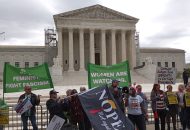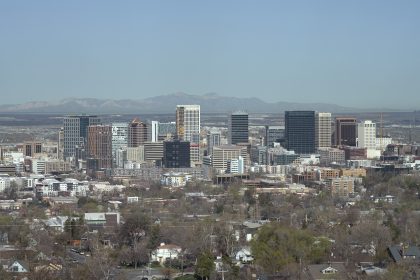Conservation Funding in Build Back Better a Boon for Climate-Smart Agriculture
COMMENTARY | The Ecomodernist

The most recent Build Back Better (BBB) proposal contains $27 billion in funding for agricultural conservation projects — that would be in addition to existing program spending — spread out over the next five years. To put this number into perspective, the Natural Resources Conservation Service, USDA’s conservation agency, received about $26 billion in total funding between 2016 and 2020.
Conservation spending is one of many important steps — alongside investing in agricultural R&D — towards decarbonizing American agriculture, and the BBB plan generously funds practices that, in the words of the bill, “either reduce or avoid greenhouse gas emissions” related to US agriculture.
Agricultural emissions make up roughly 10% of US national emissions. Compared to other countries, US agriculture is a smaller percentage of overall emissions mainly due to two factors: American farmers are technologically advanced, and have been quick to adopt climate best practices; and, the US produces more emissions per capita from transportation, buildings, and other sectors than any other country. Some look at the overall breakdown of US emissions and decide that agriculture is relatively unimportant, but that would be a mistake. Similarly, coverage of the reconciliation bill’s climate chops — with some exceptions — has focused almost exclusively on energy and other industrial sectors, leaving agriculture out of the discussion.
With the $27 billion directed towards agricultural conservation, combined with about $2 billion for agricultural research, the current Build Back Better proposal is a real step in the right direction. Ideally, the conservation proposals in BBB are a signal of what kind of policy priorities we are likely to see in the 2023 Farm Bill: large, focused on climate, and pretty quiet.
In terms of directly combatting GHG emissions from agriculture, little is as clear as BBB’s proposed cover cropping incentives. The bill includes a $25 per acre (for up to 1000 acres) payment to producers (and $5 per acre for farm owners) who adopt 1 or more cover crop practices — cover crops are planted on cropland in offseasons to protect the soil from erosion and can help sequester carbon and improve soil health, they are typically not harvested at any point — each crop year from 2022 to 2026. This alone could significantly reduce US crop production’s carbon footprint by increasing soil carbon levels. A 2018 study suggests that a $10 per acre payment for cover cropping could reduce US agricultural emissions by 100 MMT CO2e per year — almost a sixth of emissions from US agriculture. However, farmers would need to continue planting cover crops into the future or the soil carbon could be released, reversing the climate benefits.
BBB also includes some big additions to existing USDA conservation programs, like the Environmental Quality Incentives Program (EQIP), and the Conservation Stewardship Program (CSP). EQIP and CSP effectively pay farmers to adopt practices that improve the environmental impact of farms and ranches — both in terms of reducing GHG emissions, and mitigating water and air pollution. Last year, in the wake of early COVID-related economic concerns, I wrote a policy brief that called for $3.75 billion in extra funding for EQIP and CSP from 2020 to 2023, suggesting that the programs have coinciding environmental and economic benefits. BBB, as it currently stands, blows my proposal out of the water. The bill, if passed, would add $9 billion to EQIPs coffers, and another $4.1 billion to CSP over the course of FY22 to FY26.
Such a boost to conservation incentive programs would have some pretty large climate benefits for US agriculture. This is doubly true given the language of the BBB plan, which states that funding for these programs must prioritize funding to projects that “address climate change.” Paying producers to purchase equipment that can improve yields, reduce runoff, or adopt practices and adopt technologies that require less fertilizer, reduce methane emissions from cattle, or manage how animals graze can all add up to significant GHG reductions and other environmental benefits. In a recent report, we at the Breakthrough Institute found that adopting existing technologies to the extent that is possible, can reduce greenhouse gas emissions from US beef production by 41 MMT CO2e/year by 2030, or approximately a half a percent of total current US emissions.
With modest economic multipliers of 1.22 for CSP and 1.65 for EQIP — meaning that for every dollar spent CSP produces an economic benefit of $1.22 and EQIP $1.65 — conservation spending even has some chops as a stimulus for economic growth.
But that’s not all. The BBB Plan also includes:
- $7.5 billion for the Regional Conservation Partnerships Program, which funds partnered and standalone conservation projects across the US, with a focus on high-risk conservation regions.
- $200 million for Conservation Technical Assistance, a program that partners with state and regional conservation districts to develop conservation plans through voluntary conservation networks.
- $50 million for Regional Climate Hubs, a cross-agency USDA program that provides region-specific information and plans for conservation and climate mitigation for US agriculture and forestry.
- $100 million for NRCS general purpose activities, which goes towards the administrative costs of enacting the BBB conservation plan.
And, finally, the BBB plan includes $600 million for a Greenhouse Gas Inventory and Assessment Program to collect on-farm data on carbon sequestration and greenhouse gas emissions. Developing this program is crucial to both understanding the limitations and possibilities of soil carbon sequestration in agricultural soils, and designing sound policies to improve agriculture’s environmental performance.
Despite the positive direction that this conservation spending signals, innovation is also necessary to reduce emissions in the US agricultural sector as much and as fast as possible. Technological advances in beef and dairy farming, development of high-tech meat alternatives and cellular agriculture, further advances in gene editing and genetic modification, and more, are all important to minimizing emissions not just in the next few years, but for the decades to come.
If the bill passes, Build Back Better will be a boon for climate-smart agriculture, but, as almost every blog, piece, or commentary has made clear, it won’t solve everything.
Alex Smith is a Food and Agriculture Analyst at The Breakthrough Institute. You can follow him on Twitter @alexjmssmith.























